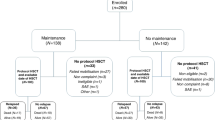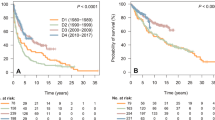Abstract
Autologous stem-cell transplantation (ASCT) has been used in follicular lymphoma (FL) to achieve durable responses in first remission or in the relapsed or refractory settings. Addition of rituximab to chemotherapy for FL has been shown to improve survival. The impact of prior therapy with rituximab upon the effectiveness of high-dose therapy (HDT) and ASCT in patients with FL is unknown. We retrospectively reviewed consecutive patients with FL who underwent HDT and ASCT. Patients were categorized according to prior therapy with rituximab. Outcomes were compared between groups in all patients and in a well-matched subset. In all 35 patients received prior rituximab and 71 rituximab-naive patients were analyzed. The rituximab-naive group had a median overall survival (OS) that was not reached during follow-up, with a median relapse-free (RFS) survival of 49.9 months. The prior rituximab group also did not reach median OS and had a median RFS of 24.6 months. Survivals were not significantly different in this group or in the well-matched subset. In conclusion, these results suggest that the use of rituximab-based regimens for the treatment of FL does not compromise the effectiveness of HDT and ASCT as a salvage strategy in patients with FL.
This is a preview of subscription content, access via your institution
Access options
Subscribe to this journal
Receive 12 print issues and online access
$259.00 per year
only $21.58 per issue
Buy this article
- Purchase on Springer Link
- Instant access to full article PDF
Prices may be subject to local taxes which are calculated during checkout




Similar content being viewed by others
References
A clinical evaluation of the International Lymphoma Study Group classification of non-Hodgkin's lymphoma. The non-Hodgkin's lymphoma classification project. Blood 1997; 89: 3909–3918 (0006-4971 (Print)).
McLaughlin P, Grillo-Lopez AJ, Link BK, Levy R, Czuczman MS, Williams ME et al. Rituximab chimeric anti-CD20 monoclonal antibody therapy for relapsed indolent lymphoma: half of patients respond to a four-dose treatment program. J Clin Oncol 1998; 16: 2825–2833.
Feuring-Buske M, Kneba M, Unterhalt M, Engert A, Gramatzki M, Hiller E et al. IDEC-C2B8 (Rituximab) anti-CD20 antibody treatment in relapsed advanced-stage follicular lymphomas: results of a phase-II study of the German low-grade lymphoma study group. Ann Hematol 2000; 79: 493–500.
Marcus R, Imrie K, Belch A, Cunningham D, Flores E, Catalano J et al. CVP chemotherapy plus rituximab compared with CVP as first-line treatment for advanced follicular lymphoma. Blood 2005; 105: 1417–1423.
Hiddemann W, Kneba M, Dreyling M, Schmitz N, Lengfelder E, Schmits R et al. Frontline therapy with rituximab added to the combination of cyclophosphamide, doxorubicin, vincristine, and prednisone (CHOP) significantly improves the outcome for patients with advanced-stage follicular lymphoma compared with therapy with CHOP alone: results of a prospective randomized study of the German Low-Grade Lymphoma Study Group. Blood 2005; 106: 3725–3732.
Schouten HC, Qian W, Kvaloy S, Porcellini A, Hagberg H, Johnson HE et al. High-dose therapy improves progression-free survival and survival in relapsed follicular non-Hodgkin's lymphoma: results from the randomized European CUP trial. J Clin Oncol 2003; 21: 3918–3927.
Rosenbaum PR, Rubin DB . The central role of the propensity score in observational studies for causal effects. Biometrika 1983; 70: 41–55.
Parson LS . Reducing bias in a propensity score matched-pair sample using greedy matching techniques. Proceedings of the 26th Annual SAS Users Group International Conference; 2001.
Young RC, Longo DL, Glatstein E, Ihde DC, Jaffe ES, DeVita Jr VT . The treatment of indolent lymphomas: watchful waiting v aggressive combined modality treatment. Semin Hematol 1988; 25 (Suppl 2): S11–S16.
Brice P, Bastion Y, Lepage E, Brousse N, Haioun C, Moreau P et al. Comparison in low-tumor-burden follicular lymphomas between an initial no-treatment policy, prednimustine, or interferon alfa: a randomized study from the Groupe d’Etude des Lymphomes Folliculaires. Groupe d’Etude des Lymphomes de l’Adulte. J Clin Oncol 1997; 15: 1110–1117.
Ardeshna KM, Smith P, Norton A, Hancock BW, Hoskin PJ, MacLennan KA et al. Long-term effect of a watch and wait policy versus immediate systemic treatment for asymptomatic advanced-stage non-Hodgkin lymphoma: a randomised controlled trial. Lancet 2003; 362: 516–522 (1474-547X (Electronic)).
Johnson PW, Rohatiner AZ, Whelan JS, Price CG, Love S, Lim J et al. Patterns of survival in patients with recurrent follicular lymphoma: a 20-year study from a single center. J Clin Oncol 1995; 13: 140–147.
Freedman AS, Neuberg D, Mauch P, Soiffer RJ, Anderson KC, Fisher DC et al. Long-term follow-up of autologous bone marrow transplantation in patients with relapsed follicular lymphoma. Blood 1999; 94: 3325–3333.
Apostolidis J, Gupta RK, Grenzelias D, Johnson PW, Pappa VI, Summers KE et al. High-dose therapy with autologous bone marrow support as consolidation of remission in follicular lymphoma: long-term clinical and molecular follow-up. J Clin Oncol 2000; 18: 527–536.
Hagenbeek A, Van Glabbeke M, Teodorovic I . The role of rituximab maintenance treatment in relapsed follicular NHL: an interim analysis of the EORTC randomized intergroup trial (Abstract). Annals of Oncology 2006; 16: 52–61.
Corradini P, Ladetto M, Zallio F, Astolfi M, Rizzo E, Sametti S et al. Long-term follow-up of indolent lymphoma patients treated with high-dose sequential chemotherapy and autografting: evidence that durable molecular and clinical remission frequently can be attained only in follicular subtypes. J Clin Oncol 2004; 22: 1460–1468.
Pohlman B, Rybicki L, Kuczkowski E, Bolwell B . Final analysis of a randomized, phase III, trial using etoposide and G-CSF with or without rituximab for peripheral stem cell mobilization in B-cell non-Hodgkins lymphoma. Blood (ASH Annual Meeting Abstracts) 2005; 106: 300.
Hochster HS, Weller E, Ryan T, Habermann TM, Gascoyne R, Frankel SR et al. Results of E1496: a phase III trial of CVP with or without maintenance with rituximab in advanced indolent lymphoma (Abstract). J Clin Oncol 2004; 22: 558–6502.
Author information
Authors and Affiliations
Corresponding author
Rights and permissions
About this article
Cite this article
Kang, T., Rybicki, L., Bolwell, B. et al. Effect of prior rituximab on high-dose therapy and autologous stem cell transplantation in follicular lymphoma. Bone Marrow Transplant 40, 973–978 (2007). https://doi.org/10.1038/sj.bmt.1705849
Received:
Revised:
Accepted:
Published:
Issue Date:
DOI: https://doi.org/10.1038/sj.bmt.1705849



